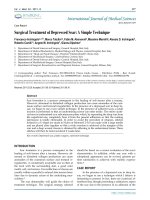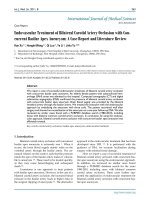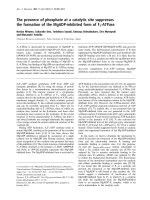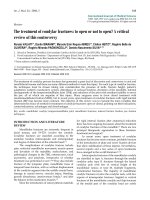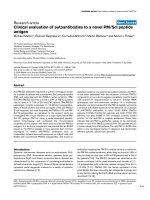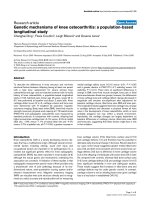Báo cáo y học: "Surgical Treatment of Depressed Scar: A Simple Technique"
Bạn đang xem bản rút gọn của tài liệu. Xem và tải ngay bản đầy đủ của tài liệu tại đây (459.62 KB, 3 trang )
Int. J. Med. Sci. 2011, 8
377
I
I
n
n
t
t
e
e
r
r
n
n
a
a
t
t
i
i
o
o
n
n
a
a
l
l
J
J
o
o
u
u
r
r
n
n
a
a
l
l
o
o
f
f
M
M
e
e
d
d
i
i
c
c
a
a
l
l
S
S
c
c
i
i
e
e
n
n
c
c
e
e
s
s
2011; 8(5):377-379
Case Report
Surgical Treatment of Depressed Scar: A Simple Technique
Francesco Inchingolo
1,4
, Marco Tatullo
2,4
, Fabio M. Abenavoli
3
,
Massimo Marrelli
4
, Alessio D. Inchingolo
5
,
Roberto Corelli
6
, Angelo M. Inchingolo
7
, Gianna Dipalma
4
1. Department of Dental Sciences and Surgery, General Hospital, Bari, Italy
2. Department of Medical Biochemistry, Medical Biology and Physics, General Hospital, Bari, Italy
3. Department of “Head and Neck Diseases”, Hospital “Fatebenefratelli”, Rome, Italy
4. Department of Maxillofacial Surgery, Calabrodental, Crotone, Italy
5. Department of Dental Sciences and Surgery, General Hospital, Bari, Italy
6. Department of Maxillofacial Surgery, General Hospital, Bari, Italy
7. Department of Surgical, Reconstructive and Diagnostic Sciences, General Hospital, Milano, Italy
Corresponding author: Prof. Francesco INCHINGOLO, Piazza Giulio Cesare – Policlinico 70124 – Bari. E-mail:
– Tel.: 00390805593343 – Infoline: 00393312111104 – Fax: 00390883347794
© Ivyspring International Publisher. This is an open-access article distributed under the terms of the Creative Commons License (
licenses/by-nc-nd/3.0/). Reproduction is permitted for personal, noncommercial use, provided that the article is in whole, unmodified, and properly cited.
Received: 2011.03.29; Accepted: 2011.06.10; Published: 2011.06.18
Abstract
Scar formation is a process consequent to the healing of soft tissues after a trauma.
However, abnormal or disturbed collagen production can cause anomalies of the cuta-
neous surface and textural irregularities. In the presence of a depressed scar in deep tis-
sue, we began to use a new simple technique. In the presence of adherent scars, a small
incision is performed so that an undermining scissor can enter inside. The entire cicatri-
cial area is undermined on a subcutaneous plane which, by separating the deep scar from
the superficial one, completely frees it from the present adhesions so that the existing
depression is totally eliminated. In order to avoid the recreation of relapses, stitches
formed in a U-shape are made in Nylon or Monocril 2-3/0 are made with a large needle
and are placed close together so that a wide aversion is achieved at the margins of the
scar and a deep wound closure is obtained by adhering to the undermined tissue. These
stitches will then be removed about 2 weeks later.
Key words: Depressed scar, plastic surgery, subcision technique
INTRODUCTION
Scar formation is a process consequent to the
healing of soft tissues after a trauma. However, ab-
normal or disturbed collagen production can cause
anomalies of the cutaneous surface and textural ir-
regularities. A cosmetically acceptable scar is often at
the level with the surrounding skin, a good color
match, soft, and narrow. Favorable lines of closure are
usually within or parallel to relaxed skin tension lines:
lines due to dynamic action of the underlying mus-
culature.
1
The scar abnormality will guide the choice of
treatment technique. The surgical strategy selected
should be based on a correct evaluation of the scar's
characteristics. In addition, while any scar with a
suboptimal appearance can be revised, greatest pa-
tient satisfaction is achieved with realistic expecta-
tions.
2
CASE REPORT
In the presence of a depressed scar in deep tis-
sue, we began to use a technique which I believe is
interesting to present. In fact, there are cicatricial af-
tereffects that, though presenting a satisfactory aspect
of the scar due to the presence of an adhesion of the
Ivyspring
International Publisher
Int. J. Med. Sci. 2011, 8
378
skin to the underlying plane, disfigure somewhat in a
disagreeable manner and therefore reconstructive
plastic surgery should be performed (Fig.1). Thus, in
these cases especially when there is not a lack of tissue
secondary to trauma as for example the suffering of
sub-cutaneous adipose tissue, it would be sufficient to
eliminate the single adhesion without reopening the
entire scar again.
Therefore, with this objective in mind, in the
presence of adherent scars, after having infiltrated the
whole area with a solution of Lidocaine 0.5% and
Epinephrine 1:200,000 very close to one of the two
edges of the scar, a small incision is performed so that
an undermining scissor can enter inside (Fig.2).
The entire cicatricial area is undermined on a
subcutaneous plane which, by separating the deep
scar from the superficial one, completely frees it from
the present adhesions so that the existing depression
is totally eliminated (Fig.3).
At the end of this manoeuvre, in order to avoid
the recreation of relapses, stitches formed in a
U-shape are made in Nylon or Monocril 2-3/0 are
made with a large needle and are placed close to-
gether so that a wide aversion is achieved at the mar-
gins of the scar and a deep wound closure is obtained
by adhering to the undermined tissue (Fig.4). These
stitches will then be removed about 2 weeks later.
Afterwards, the patient should start to carry out
massages on the entire treated area using moisturiz-
ing cream to aid the mobility of the recuperated tis-
sue.
Fig.1: An example of a depressed scar of the abdomen.
Fig.2: A small incision with an undermining scissor inside
it.
Fig.3: The scar is completely undermined
Fig.4: The final result
Int. J. Med. Sci. 2011, 8
379
CONCLUSIONS
Subcision incision is a very effective technique
for correcting atrophic scars. Essentially, the physician
inserts a needle and sweeps it back and forth repeat-
edly to free the skin from the underlying scar tissue.
Normally, the dissection plane of subcision is
rather superficial: it is a subdermal dissection per-
formed successfully in the treatment of acne scars. In
this novel technique, we perform a deeper dissection
plane and it is designed in order to remove adhesions
that attach the skin to the floor below. Infact, the use
of the stitches in depth is performed in order to pre-
vent that the adhesion can recreate again: this relapse
could promote the formation of a layer of reactive
collagen in the region below the treated area.
We therefore believe that this technique can be
utilized as a simple and safe technique that brings
great improvement to the treatment of depressed
scars.
AUTHORS' CONTRIBUTIONS
FI: participated in the surgical treatment and in
the follow-up of this patient. MT: drafted the manu-
script and reviewed the literature. FMA: participated
in the surgical treatment and in the follow-up of this
patient. MM: participated in the design of this case
study and in the follow-up of this patient. ADI: re-
vised the literature sources. RC: participated in the
surgical treatment and in the follow-up of this patient.
AMI: documented this case report with digital pic-
tures. GD: participated in the follow-up of this pa-
tient. All the authors read and approved the final
manuscript.
CONSENT STATEMENT
Written informed consent was obtained from the
patient for publication of this case report and accom-
panying images.
Conflict of Interest
The authors have declared that no conflict of in-
terest exists.
References
1. Thomas JR, Prendiville S. Update in scar revision. Facial Plast
Surg Clin North Am 2002;10(1):103-11
2. Jacob CI, Dover JS, Kaminer MS. Acne scarring: a classification
system and review of treatment options. J Am Acad Dermatol
2001;45(1):109-17
